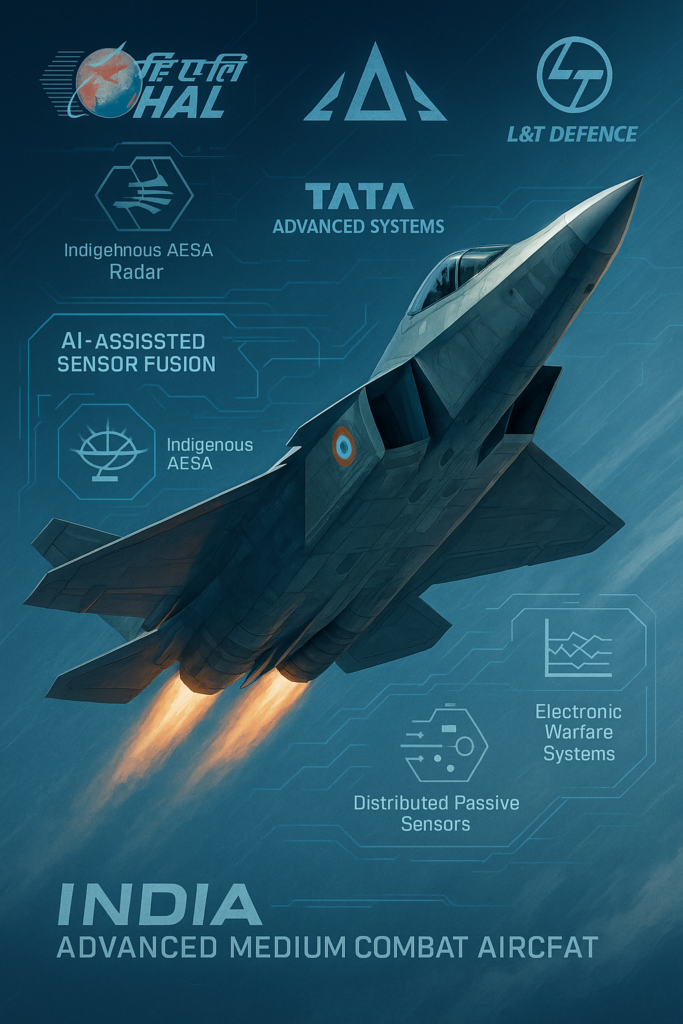
- The Indian government has recently shifted from HAL’s manufacturing monopoly by forming a Special Purpose Vehicle (SPV) with ADA, HAL, and private players like Tata Advanced Systems and L&T Defence.
- The 25-tonne, twin-engine AMCA is designed for air superiority, ground strikes, SEAD, and electronic warfare, aiming to replace the IAF’s ageing Su-30MKI fleet with seven planned squadrons (126 jets).
- The AMCA will feature advanced sensors, including an indigenous AESA radar like Netra, distributed passive sensors, and AI-assisted multi-sensor data fusion. Its “E-Pilot” AI system will support pilots in complex combat scenarios, similar to pilot-assist features in the F-35 and J-20.
- A major challenge for the AMCA program is developing a high-thrust, reliable jet engine meeting fifth-gen standards. India’s Kaveri engine, though a technological milestone, currently delivers only 70–75 kN—well short of the 110–130 kN needed for supercruise and thrust vectoring.
India’s journey to build its fifth-generation stealth fighter, the Advanced Medium Combat Aircraft (AMCA), is one of ambition, innovation, and national pride. It is a thrilling leap toward securing India’s skies and showcasing technological prowess in aerial warfare. Led by the Aeronautical Development Agency (ADA) under the Defence Research and Development Organisation (DRDO), set to be manufactured by Hindustan Aeronautics Limited (HAL) and now private players, India’s AMCA targets stealth, supercruise, and multirole capabilities by 2035. With the Indian Air Force (IAF) facing a critical squadron shortage, the AMCA is crucial in countering China’s threats of J-20s and potential J-35s. The decision of the Defence Ministry to involve private players via a Special Purpose Vehicle (SPV) is a game-changer, promising faster timelines and greater opportunities for innovation. Yet, challenges like engine development and stealth technology loom large with the IAF Chief raising concerns over delays, urging accountability and deeper industry collaboration. This article dives into the AMCA’s journey, hurdles, prospects, and why private and global partnerships could make India an emerging aerospace powerhouse.
Who’s behind the AMCA?The role of ADA
When people hear about India making fighter jets, they often think of HAL (Hindustan Aeronautics Limited). But here’s the real story: HAL is the manufacturer, not the designer. The scientific brains behind the AMCA are at ADA (Aeronautical Development Agency), which is part of DRDO. ADA does the heavy lifting vis-à-vis designing, simulating, and solving the hard physics problems that make a stealth jet possible. HAL’s role kicks in once the design is ready; they figure out how to build the thing, focusing on assembly, production lines, and the nuts-and-bolts of manufacturing. This charted division of labour ensures that, while ADA takes care of the research and innovation like stealth shaping, avionics and aerodynamics, HAL and now, private companies, will focus on making those designs real and getting them soar into the skies.
Private Sector: A Turbo Boost for AMCA
For decades, India’s fighter jet dreams were built almost entirely by HAL, but the AMCA project is changing the rules of the game. A major recent shift is the Indian government’s decision to include private players via a Special Purpose Vehicle (SPV), a teaming of ADA, HAL with private players, marking a shift from HAL’s sole manufacturing monopoly and making companies like Tata Advanced Systems and L&T Defence participate directly. This move is expected to inject innovation, speed, and efficiency into the program. India’s private aerospace sector has rapidly advanced in the last five years, and its involvement could cut down manufacturing timelines by up to five years, potentially making the first AMCA flight-ready by 2030. On May 29, 2025, Air Chief Marshal AP Singh, speaking at the CII Business Summit, hailed the SPV as a “big step” for indigenisation but warned that timelines are a big issue. He urged accountability, stating, “We sign contracts knowing delivery won’t happen; this must change.” Tata’s C-295 facility delivered its first Airbus in 2024, while L&T’s stealth-grade composites supply Boeing, showcasing precision and promise.
AMCA: A Vision for India’s Air Dominance
The AMCA is a 25-tonne, twin-engine fighter designed for air superiority, ground strikes, suppression of enemy air defences (SEAD), and electronic warfare. It aims to replace the IAF’s ageing Sukhoi Su-30MKI fleet, with seven squadrons (126 jets) planned. In March 2024, the government approved ₹15,000 crore for five prototypes, targeting a first flight by 2028 and induction by 2035. The ADA’s preliminary design, unveiled at Aero India 2025, features stealth elements like radar-absorbent materials (RAM) and internal weapons bays, aiming for a radar cross-section (RCS) of 0.1 sqm, rivalling the specs of the best of the lot, like the F-35. With the IAF left at 30 squadrons and staring at the retirement of its MiG-21, Jaguar fleets against the required 42 squadrons, the AMCA is specifically critical. Its AI-driven systems and unmanned teaming ensure future readiness, but mastering stealth and propulsion is a steep climb.
The 5th Gen Battle: Comparison with F-35, J-20, J-35, and Su-57
AMCA boasts of supercruising design, directed energy weapon readiness, AI integration, Hybrid unmanned-manned teaming with a hypersonic weapon capability, making it stand tall among the crowd. When comparing India’s AMCA to established fifth-generation fighters such as the American F-35, Chinese Chengdu J-20 and Shenyang J-35, and the Russian Su-57, several key aspects stand out, ranging from design philosophy and stealth features to avionics, operational flexibility, and strategic intent.
The AMCA is being designed as a twin-engine fighter, with each engine expected to produce between 110 and 125 KN of thrust. This puts it in the same league as the J-20s, J-35s, and Su-57s, all of which are also twin-engine jets, giving it a potential edge in power and survivability over the single-engine F-35. In terms of speed, the AMCA is projected to reach a maximum of around Mach 2.15, making it faster than the F-35 and slightly edging past the J-20 and Su-57, both of which are known for their high-speed capabilities. The AMCA is expected to have a combat range of about 1,620 kilometres, which is slightly higher than the F-35 and in line with the J-20 and Su-57. Its payload capacity, at around 6,500 kilograms, is competitive, though the J-20 can reportedly carry more, and the F-35 and Su-57 also can carry higher payloads. However, the AMCA’s focus is on a balance of stealth, agility, and indigenous systems, rather than sheer payload.
In terms of avionics and situational awareness, the AMCA is designed to feature a suite of advanced sensors, embedding an indigenous AESA radar like Netra, distributed passive sensors, and AI-assisted multi-sensor data fusion. The “E-Pilot”, an AI-based decision support system, will help pilots manage complex combat scenarios and threats, similar to the sensor fusion and pilot-assist features found in F-35s and J-20s. The AMCA’s cockpit will be highly digital, with a panoramic touchscreen, wide-angle heads-on-display (HUD), and hands-on-throttle-and-stick (HOTAS) controls like Gamers, matching or exceeding the pilot interface sophistication of its global peers.
| Feature | AMCA (India) | F-35 (USA) | J-20 (China) | J-35 (China) | Su-57 (Russia) |
|---|---|---|---|---|---|
| Engines | Twin (110–125 kN, planned) | Single (191 kN) | Twin (WS-10/WS-15) | Twin | Twin |
| Max Speed | Mach 2.15 (2,600 km/h) | Mach 1.6 (2,000 km/h) | Mach 2.0+ | Mach 1.8+ | Mach 2.0 |
| Combat Range | 1,620 km | 1,239 km | ~1,200+ km | ~1,200+ km | 1,500+ km |
| Payload | 6,500 kg (1500 kg internal) | 8,160 kg | ~11,000 kg | ~8,000 kg | 7,400 kg |
| Stealth | 5th/5.5 gen, all-aspect | 5th gen, frontal | 5th gen, frontal | 5th gen, frontal | 5th gen, frontal |
| Avionics | AESA radar, AI fusion | AESA, sensor fusion | AESA, sensor fusion | AESA, sensor fusion | AESA, sensor fusion |
| Unique Features | AI pilot, UAV teaming | MADL, global logistics | Long-range missiles | Carrier-capable | Supermaneuverability |
AMCA’s strengths: The Desi tadka of Speed, Stealth and Power
Stealth is where the AMCA aims to truly shine. Its design emphasises all-aspect stealth, meaning it seeks to be less visible not just from the front, but from all directions. This is a step up from some rivals, which focus primarily on frontal stealth (as it is the first thing most radars see). However, frontal stealth can fail when an aircraft is exposed to radar from angles other than the front, such as from the sides or above, making it detectable by modern multi-static or low-frequency radars. For instance, Anti-Stealth VHF-SR (Very High Frequency-Short Range) surveillance radars like Virupaksha integrated into Su-30MKI can counter Stealth aircraft from BVR (Beyond Vision Range) distances as far as 600 km. Like its peers, the AMCA will feature an advanced AESA radar and sensor fusion, integrating data from multiple sensors to give pilots a decisive edge in battle. Stealth isn’t just about dodging radar, it requires minimising infrared (IR) signatures, electromagnetic emissions, and noise.
The AMCA will use features like serpentine air intakes, internal weapons bays, and radar-absorbent materials to stay hidden. Advanced avionics, sensor fusion, and AI-driven systems will help the pilot stay aware and react faster than the enemy. India’s plan to incorporate AI-driven avionics and the potential for teaming with unmanned aerial vehicles (UAVs) as the loyal wingman could give the AMCA unique operational flexibility.
The aim is not total invisibility, but to delay detection, confuse enemy sensors, and reduce the time adversaries for the Jet to respond. A low RCS demands precision manufacturing, where a misaligned panel can betray the aircraft. The ADA’s indigenous RAM and conformal antennas show progress, but scaling for production is challenging. Suppressing IR signatures needs advanced exhaust designs and heat-dissipating materials, areas where India’s expertise is developing. Integrating AESA radar and IRST systems stretches R&D capacity, trailing leaders like the US and China. Directed-energy weapons, better engines and superior electronic warfare systems are planned for the Mk2 version, thus positioning AMCA as a 5.5 to sixth-generation platform, while Mk1 focuses on rapidly bolstering IAF squadrons with proven fifth-generation features.
Engine Roadblocks and International Collaboration: The Path Forward for AMCA
One of the most formidable challenges facing the AMCA program is the development of a high-thrust, reliable jet engine that meets fifth-generation fighter requirements. India’s indigenous Kaveri engine project, while a technological milestone, has so far fallen short (70-75 kN) in delivering the sustained 110-130 kN thrust needed for AMCA’s supercruise and thrust vectoring capabilities. This gap in propulsion technology is not unique to India; even advanced nations face ongoing hurdles in jet engine development due to the extreme demands on materials, manufacturing precision, and thermal management. Even China, with a defence budget of $471 billion, can’t get it right. To overcome this, India is actively pursuing international partnerships and offers from French aerospace giant Safran and Japan’s XF9-1 for a 100% technology transfer and co-development of a new sixth-generation engine specifically tailored for AMCA and not just an upgraded version of existing models like the M88 (used in Rafales). By integrating foreign expertise with domestic R&D, India aims to bridge its engine technology gap, positioning the AMCA as a truly world-class stealth fighter.
Prospects: A Game-Changer for India’s Aerospace Future
The AMCA could place India among the elite with fifth-generation fighters, joining the US, China, and Russia. Its 1,500 kg internal payload, AI-driven electronic pilot, and net-centric warfare capabilities ensure a combat edge. The modular design supports sixth-generation upgrades like active cloaking. Private involvement could spark an aerospace boom, attracting global OEMs, boosting exports, and creating jobs under “Make in India.” With China fielding 200 J-20s by 2025 and Pakistan eyeing FC-31s, the AMCA is a strategic must. By blending Safran’s tech, private agility, and ADA’s vision, if India can deliver the first AMCA by 2030, it will prove its sceptics wrong and pave the way for India to be a Vishwaguru in Aerial Warfare.
Abhinav is an accomplished Engineer, Technical Writer and consultant, who has worked for prestigious Navratna PSUs of India. He is an expert on matters related to Defense and Technology. Views are personal.
